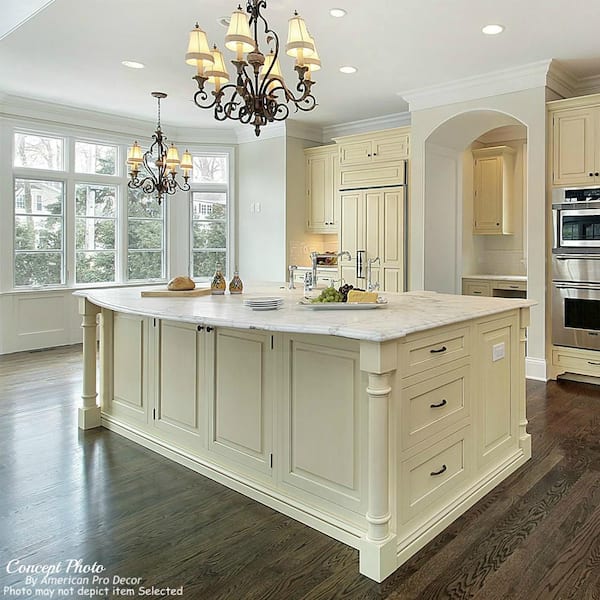An Overview to Choosing the Perfect Legs For Kitchen Area Island for Your Home
Picking the suitable legs for your kitchen area island is a nuanced decision that affects both the performance and visual appeal of this main room. As you think about these components, it comes to be evident that the appropriate legs can transform not just the appearance of your kitchen area but also its use for years to come.

Recognizing Kitchen Island Legs
When picking legs for a kitchen area island, it's essential to comprehend their functional and aesthetic functions in the overall style. The legs function as an essential support group, making certain stability and longevity for the island, which frequently operates as a workspace, dining location, or collecting spot. The selection of material and construction method need to be durable enough to endure everyday usage and possible wear.
Along with their architectural responsibilities, legs contribute substantially to the island's aesthetic allure. They can enhance the kitchen's style, whether with standard, modern, or diverse layouts. The elevation and percentage of the legs are additionally critical considerations; they should harmonize with the island's counter top height while guaranteeing comfortable seating for those using the area.
Furthermore, the leg style can influence the overall flow of the kitchen. Open, ventilated leg designs can develop a feeling of lightness, while solid, substantial legs might share a more grounded and stable aesthetic - Legs For Kitchen Island. Recognizing these visual and practical aspects will guide homeowners in making educated selections that enhance their kitchen area's design and enhance its use
Popular Styles and Products
The choice of legs for a kitchen area island encompasses a variety of preferred designs and materials, each offering unique characteristics that can enhance both capability and visual appeals. Among one of the most in-demand styles are modern, rustic, and typical. Contemporary legs commonly feature sleek, minimal styles that emphasize simpleness and clean lines, making them excellent for modern-day kitchen areas. Rustic designs, on the other hand, embrace all-natural elements and commonly showcase recovered wood or distressed finishes, adding heat and charm to the room. Conventional legs typically display luxuriant details and workmanship, enhancing timeless kitchen styles.

Height and Security Considerations

The legs of the kitchen area island should supply adequate support, guaranteeing that the framework can endure day-to-day use without moving or tottering. Material choice plays a substantial role in security; steel legs, for instance, have a tendency to supply greater stamina contrasted great site to timber.
Matching Your Kitchen Visual
Picking the right legs for your kitchen area island surpasses functionality; it likewise plays a substantial duty in the overall visual of the room. When choosing legs, think about the design style of your cooking area. For a modern appearance, sleek metal or minimalist styles can develop a tidy, modern vibe. On the other hand, rustic or typical kitchens usually gain from wooden legs with elaborate outlining or a troubled coating, boosting heat and personality.
Legs that match or contrast with your island's surface and bordering kitchen cabinetry can develop aesthetic consistency or striking focal points. Furthermore, think about the surface of the legs; matte, glossy, or textured finishes can considerably affect the total feel of the kitchen area.
Installation and Maintenance Tips
Setting up kitchen island legs needs careful attention to detail to make sure both stability and aesthetic appeal. Begin by choosing an appropriate location for your island, guaranteeing it is level and has adequate space for activity. Use a stud finder to find wall studs if you are affixing the legs to a wall or making use of brackets for included support. Mark the placement of the legs precisely prior to drilling.
When securing the legs, use top notch screws and, if necessary, timber glue for extra stamina. For steel legs, ensure that you are utilizing proper supports and devices to avoid damages to your floor covering. It is advisable to look for levelness after setup, making changes as required to avoid wobbling.
Maintenance is similarly crucial for long life - Legs For Kitchen Island. Routinely inspect the legs for any type of indications of wear or helping to loosen, specifically in high-traffic locations. Tidy the legs with an ideal cleaner, staying clear of unpleasant materials that may damage the surface area. For wood legs, take into consideration using a timber conditioner occasionally to keep their coating. By adhering to these installment and upkeep ideas, you can make certain that your cooking area island legs continue to be both practical and visually attractive.
Conclusion
In verdict, picking the suitable legs for a kitchen island demands mindful consideration of height, security, and aesthetic compatibility. By choosing ideal materials and designs that line up with the overall cooking article area style, functionality can be boosted while preserving visual allure. Appropriate installation and continuous maintenance better add to the resilience and long life of the kitchen area island. Ultimately, thoughtful leg choice plays an important role in boosting both the practicality and layout of the kitchen area room.
When picking legs for a kitchen island, it's necessary to understand their aesthetic and functional duties in the total design. Open, ventilated leg designs can create a sense of agility, while strong, substantial legs may share a more grounded and steady visual. The legs of the kitchen area island should offer sufficient support, making certain that the structure can stand up to everyday usage without shifting or wobbling.Mounting kitchen island legs calls for mindful focus to information to guarantee both stability and visual allure.In verdict, selecting the More about the author suitable legs for a kitchen area island requires mindful factor to consider of elevation, security, and visual compatibility.